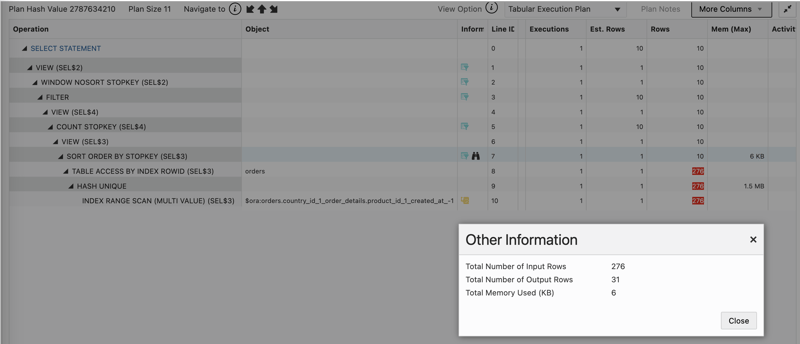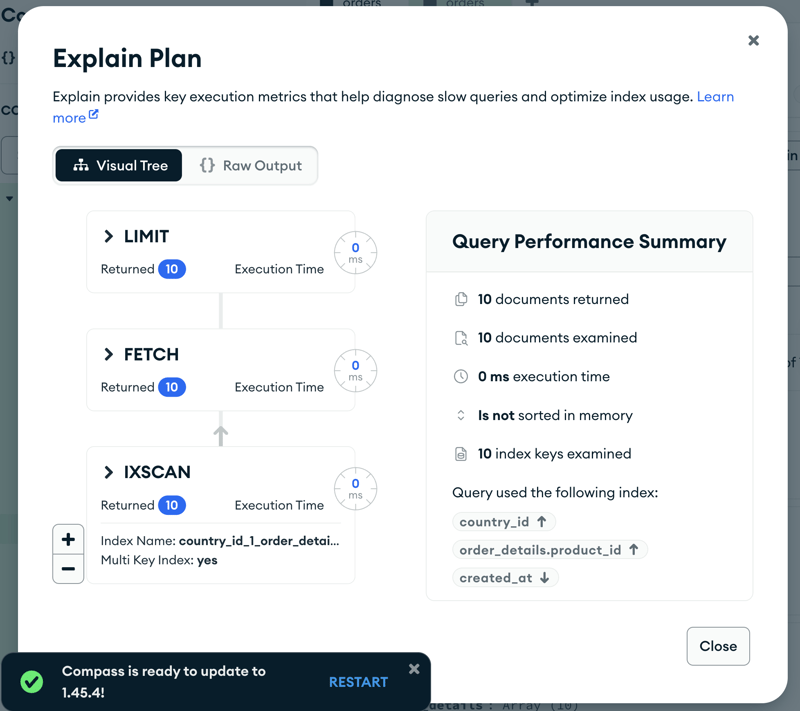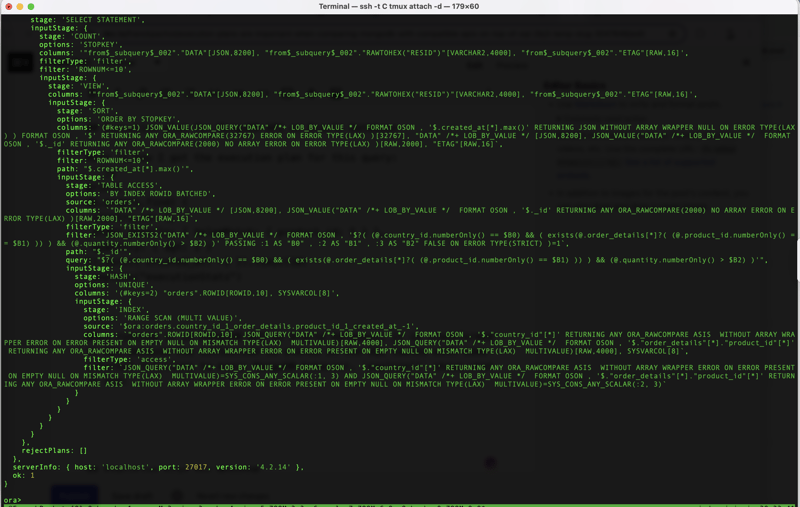This content originally appeared on DEV Community and was authored by Franck Pachot
MongoDB is the standard API for document databases, and some cloud providers have created a service with a similar API. AWS and Azure call theirs 'DocumentDB', and Oracle provides the MongoDB API as a proxy on top of its SQL database. These databases provide a subset of features from past versions of MongoDB, but user experience and performance are also crucial.
Oracle claims better performance, and I will use it to compare the execution plans to see which one minimizes unnecessary row reads.
TL;DR: MongoDB has better performance, and more indexing possibilities.
Document Model (Order - Order Detail)
I used a simple schema of orders and order lines, ideal for a document model. I illustrated it with UML notation to distinguish strong and weak entities, representing the association as a composition (⬧-).
In a SQL database, a one-to-many relationship between orders and line items requires two tables. In MongoDB, a composition relationship allows the weak entity (Order Details) to be embedded within the strong entity (Order) as an array, simplifying data management and enhancing performance, as we will see when indexing it.
I will insert orders with few attributes. The country and creation date are fields in Order. The line number, product, and quantity are fields of Detail, which is an embedded array in Order:
+--------------------------+
| Order |
+--------------------------+
| country_id: Number |
| created_at: Date |
| details: Array |
| +----------------------+ |
| | Detail | |
| +----------------------+ |
| | line: Number | |
| | product_id: Number | |
| | quantity: Number | |
| +----------------------+ |
+--------------------------+
Sample Data
I generate one million documents for my example. I'll focus on predictable metrics like the number of documents examined rather than execution time, so that it can be easily reproduced with a small dataset. To simulate products with fluctuating popularity, I use a randomized logarithmic value to create product IDs:
const bulkOps = [];
for (let i = 0; i < 1000000; i++) {
const orderDetails = [];
for (let line = 1; line <= 10; line++) {
orderDetails.push({
line: line,
product_id: Math.floor(Math.log2(1 + i * Math.random())),
quantity: Math.floor(100 * Math.random()),
});
}
bulkOps.push({
insertOne: {
document: {
country_id: Math.floor(10 * Math.random()),
created_at: new Date(),
order_details: orderDetails
}
}
});
}
db.orders.bulkWrite(bulkOps).insertedCount;
Access Pattern and Index
Users seek insights into product usage through a query for the most recent orders that include a specific product, in a specific country. Following the ESR rule, I created an index with equality fields in front of the key, followed by the fields for ordering results.
db.orders.createIndex( {
"country_id": 1,
"order_details.product_id": 1,
"created_at": -1
});
Query the 10 last orders for a product / country
I queried the ten last orders in country 1 including product 5:
print(
db.orders.find({
country_id: 1,
order_details: { $elemMatch: { product_id: 5 } }
}).sort({ created_at: -1 }).limit(10)
);
Execution plan for MongoDB API on Oracle Database
Here is how I got the execution plan for this query:
print(
db.orders.find( {
country_id: 1,
order_details: { $elemMatch: { product_id: 5 } }
}).sort({ created_at: -1 }).limit(10)
.explain("executionStats")
);
When running it on MongoDB API on Oracle Database, it is transformed to SQL because the collection is stored in the SQL tables with some internal functions to mimic MongoDB behavior. explain() shows what is run:
Unfortunately, this does not show the execution statistics.
To gain more insights, I gathered the SQL statement from V$SQL and ran it with the MONITOR hint to generate a SQL Monitor report:
select /*+ FIRST_ROWS(10) MONITOR */ "DATA",rawtohex("RESID"),"ETAG"
from "ORA"."orders"
where JSON_EXISTS("DATA"
,'$?( (@.country_id.numberOnly() == $B0) &&
( exists(@.order_details[*]?( (@.product_id.numberOnly() == $B1) )) ) )' passing 1 as "B0", 5 as "B1" type(strict))
order by JSON_QUERY("DATA", '$.created_at[*].max()') desc nulls last
fetch next 10 rows only
;
Here is the SQL Monitor report:

- 276 rows have been read from the index (INDEX RANGE SCAN). The access predicates are internal virual columns for the equality conditions:
"orders"."SYS_NC00005$"=SYS_CONS_ANY_SCALAR(1, 3) AND "orders"."SYS_NC00006$"=SYS_CONS_ANY_SCALAR(5, 3) - they are deduplicated (HASH UNIQUE)
- 276 documents are fetched (TABLE ACCESS BY ROWID)
- they are sorted for Top-k (SORT ORDER BY STOPKEY) to return 31 documents, from which 10 are fetched
More operations occur to transform it to MongoDB-compatible documents, but this occurs on 10 documents as it happens after the limit (COUNT STOPKEY)
This doesn't follow the MongoDB ESR (Equality, Sort, Range) rule. The index was used only to filter on the equality predicates, on country_id and product_id but having created_at next was not used to get the document in order.
The result from Oracle Database is compatible with MongoDB, but not the performance.
Execution plan for MongoDB
Here is the execution plan on the real MongoDB:
db> print(
... db.orders.find( {
... country_id: 1,
... order_details: { $elemMatch: { product_id: 5 } }
... }).sort({ created_at: -1 }).limit(10)
... .explain("executionStats").executionStats
... );
{
executionSuccess: true,
nReturned: 10,
executionTimeMillis: 0,
totalKeysExamined: 10,
totalDocsExamined: 10,
executionStages: {
isCached: false,
stage: 'LIMIT',
nReturned: 10,
executionTimeMillisEstimate: 0,
works: 11,
advanced: 10,
needTime: 0,
needYield: 0,
saveState: 0,
restoreState: 0,
isEOF: 1,
limitAmount: 10,
inputStage: {
stage: 'FETCH',
filter: {
order_details: { '$elemMatch': { product_id: { '$eq': 5 } } }
},
nReturned: 10,
executionTimeMillisEstimate: 0,
works: 10,
advanced: 10,
needTime: 0,
needYield: 0,
saveState: 0,
restoreState: 0,
isEOF: 0,
docsExamined: 10,
alreadyHasObj: 0,
inputStage: {
stage: 'IXSCAN',
nReturned: 10,
executionTimeMillisEstimate: 0,
works: 10,
advanced: 10,
needTime: 0,
needYield: 0,
saveState: 0,
restoreState: 0,
isEOF: 0,
keyPattern: {
country_id: 1,
'order_details.product_id': 1,
created_at: -1
},
indexName: 'country_id_1_order_details.product_id_1_created_at_-1',
isMultiKey: true,
multiKeyPaths: {
country_id: [],
'order_details.product_id': [ 'order_details' ],
created_at: []
},
isUnique: false,
isSparse: false,
isPartial: false,
indexVersion: 2,
direction: 'forward',
indexBounds: {
country_id: [ '[1, 1]' ],
'order_details.product_id': [ '[5, 5]' ],
created_at: [ '[MaxKey, MinKey]' ]
},
keysExamined: 10,
seeks: 1,
dupsTested: 10,
dupsDropped: 0
}
}
}
}
Here MongoDB didn't read more rows than necessary:
- Index scan (
stage: 'IXSCAN') with a single access (seeks: 1) to the values of the equality condition: - Read only the ten index entries (
keysExamined: 10) needed for the result - No sort operation, the ten documents (nReturned: 10) are read (stage: 'IXSCAN')
This is summarized by:
executionSuccess: true,
nReturned: 10,
totalKeysExamined: 10,
totalDocsExamined: 10,
When the number of keys and documents examined match exactly the number of documents returned, no unnecessary operations occurred, and the execution is optimal.
You can also see that from the visual execution plan in MongoDB Compass:

With document data modeling and MongoDB indexes, you read only what you need and the cost of the query is proportional to the result.
Conclusion on Documents (vs. relational) and MongoDB (vs. emulations)
In a SQL database, the Orders - Order Details example requires two tables and a join to filter results. The join itself may not be too expensive, but SQL databases lack multi-table indexes. They do unnecessary work reading and joining rows that will be discarded later.
The document model, with embedded entities, allows for comprehensive indexing, offering optimal access unlike normalized tables in relational databases. MongoDB shines with indexes that follow Equality, Sort, and Range, and they can cover documents and sub-documents, with multiple keys per document.
While some SQL databases have copied the MongoDB API for its user-friendly experience, they do not gain the same benefits as MongoDB, provide fewer indexing possibilities, and incur additional operations when executing queries.
This content originally appeared on DEV Community and was authored by Franck Pachot
Franck Pachot | Sciencx (2025-03-09T23:56:16+00:00) Comparing Execution Plans: MongoDB vs. Compatible APIs. Retrieved from https://www.scien.cx/2025/03/09/comparing-execution-plans-mongodb-vs-compatible-apis/
Please log in to upload a file.
There are no updates yet.
Click the Upload button above to add an update.


